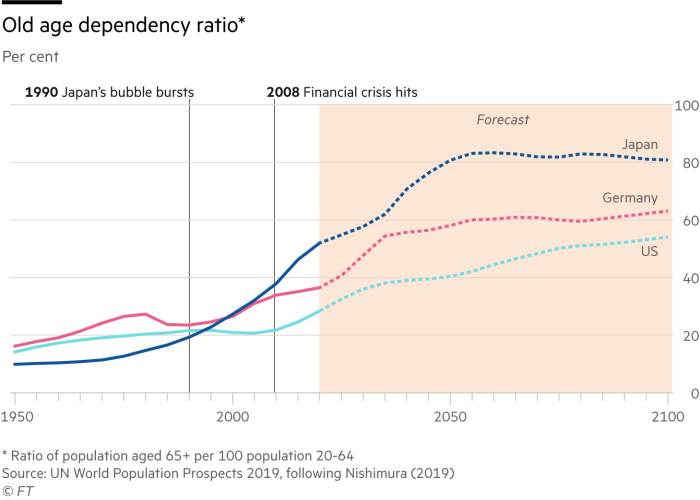In Sovereign Debt Disaster, Dimitris Chorafas defines Japanification “as a time period of financial plight which is neither outright chapter nor significantly better than a corridor of mirrors.” In different phrases, Japanification is a attribute of an economic system that has misplaced traction in its progress and is caught in an prolonged interval of low rates of interest, low inflation, and excessive authorities indebtedness.
A lot of the developed world is at completely different levels of Japanification, with Europe being the furthest alongside. Some rising international locations (e.g., China) might doubtlessly observe swimsuit. So, how ought to we allocate capital in a world the place progress is subdued, risk-free investments (in lots of cases) are unfavourable yielding, and recession may very well be lurking across the nook?
Deglobalization: An Consequence of Japanification?
The 1985 Plaza Accord resulted in a big appreciation of the yen, bringing Japanese exports to a standstill and abruptly halting progress. In consequence, the federal government in Tokyo launched a collection of expansionary financial insurance policies: rates of interest have been slashed, and financial stimulus was launched. These measures resulted in asset bubbles, notably within the inventory and actual property markets. In a delayed response to the bubble burst, the Financial institution of Japan launched into an unconventional path of a zero rate of interest coverage (ZIRP) in 1999.
However ZIRP failed to lift inflation in Japan. Europe and the U.S. have had comparable experiences with low, zero, and even unfavourable rates of interest. One potential argument is that in a globalized world, aggressive forces result in lack of pricing energy by firms. How can U.S. producers compete with cheaper Chinese language producers which have comparable scale? The present wave of commerce wars and deglobalization, thus, seems to have some roots in an incapability to provide inflation or a concern of deflation.
The Rise of the Strolling Lifeless
When the bubble burst in Japan within the Nineties, the Financial institution of Japan tried to stimulate progress by means of rock-bottom rates of interest and financial stimulus. This transfer gave start to “zombie” firms, which have been stored on life assist by low-cost financing. These companies are in such unhealthy form that they can not even service their present debt with their present earnings. In a well-functioning capitalist system, such firms can be allowed to go belly-up, liberating up assets from the extra productive components of the economic system.
Sadly, sustained low charges led to a thriving inhabitants of those zombie firms, not simply in Japan but in addition in the remainder of the world. In accordance with the Financial institution for Worldwide Settlements, throughout 14 superior economies, zombies now quantity 12 % of all publicly listed firms. The variety of zombie companies within the S&P 1500 elevated from 2 % to 14 % between 1987 and 2018, in line with evaluation by Bianco Analysis.
After we prop up a military of strolling lifeless firms, productiveness suffers and inflation stays subdued. When charges are low, such zombies fly beneath the radar. But when charges rise even modestly, or a recession pummels everybody throughout the board? A impolite awakening might await such firms and their buyers. Expert lively buyers ought to be capable of establish and keep away from such troubled firms. However passive buyers in, say, the S&P 1500 will discover 14 % of their portfolio zombified. If a wave of company defaults ensues, it might result in panic basket promoting, deepening a sell-off.
The (De)inhabitants Bomb
In 1968, the discharge of Paul Ehrlich’s best-selling e book, The Inhabitants Bomb, percolated fears {that a} inhabitants bomb would tip the world into chaos. The fact that many international locations face at present—and that Japan has been coping with for practically three many years—is sort of the opposite. Japan’s working-age inhabitants (aged 15-64) peaked in 1991, and the overall inhabitants began to say no in 2011. Statisticians, nonetheless, continued to forecast a return to larger start charges. That forecast led to overcapacity and deflation as a result of firms mistakenly overinvested within the expectation of a better inhabitants.
The subsequent 20 years will contain dramatic growing older in developed international locations, with Korea and China additionally at a turning level. As individuals age and retire, they spend much less and save extra. This dynamic pushes down costs and rates of interest. Inhabitants decline could be a slowly ticking time bomb, which might be combated by permitting motion of capital and labor. If an economic system is totally globalized, then even when the home inhabitants declines, the worldwide inhabitants nonetheless grows. Financial savings from an growing older economic system might stream right into a youthful economic system that may supply larger funding returns. This isn’t an choice, nonetheless, when international locations are doing precisely the alternative—closing their borders.

How Do You Put money into a Japanified World?
Sadly, Japanification to completely different levels is probably going the brand new regular for a lot of the world, a actuality that we might discover ourselves in for many of our investing careers. When investing on this backdrop, you will need to maintain three factors in thoughts.
First, when inflation is prone to stay low at the same time as financial coverage reaches the bounds of risk, we need to discover ourselves invested in firms which have pricing energy that can not be competed away. In different phrases, search for firms which can be shielded from new entrants on account of constraints (mental capital, coverage, community results, and so forth.).
Second, rates of interest are prone to stay subdued within the close to to medium time period in a lot of the developed world. At such low charges of financial progress, it doesn’t take a lot to tip economies right into a recession. When recession hits, stability sheet fundamentals change into critically vital, and solely the strongest survive. You do not need to be stranded holding a handful of zombies on the day of reckoning.
Third, a secular stagnation in an economic system can probably be addressed with aggressive fiscal and financial coverage. There are, in fact, penalties to such measures, as we noticed within the case of Japan. However a secular stagnation in inhabitants requires adaptation by the human race, which is extra advanced and might take a for much longer time. Within the meantime, companies that adapt to or service a altering demographic will thrive, and people are the companies that buyers ought to take into account.
Secular and aggressive benefits of firms which have pricing energy, have sturdy fundamentals, and have a enterprise mannequin that caters to a altering international demographic might help us navigate the maze of Japanification.
Editor’s Word: The unique model of this text appeared on the Impartial Market Observer.
